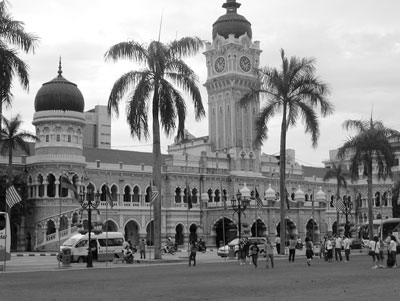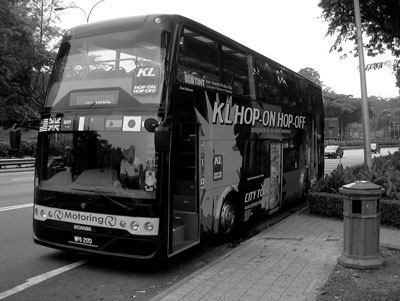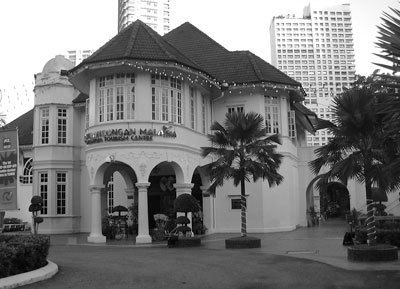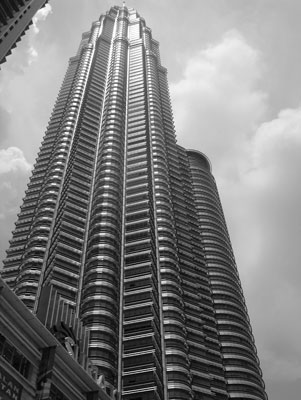KL Hop-on Hop-off
This item appears on page 74 of the November 2008 issue.
by Jay Brunhouse
I hopped on at stop #22 Ampang Park in front of Malaysia’s Hotel Nikko Kuala Lumpur, where I stayed. I climbed the stairs to the upper desk of the brightly decorated, black, double-decked “KL Hop-on Hop-off” bus and we sped past the relatively modest Buddhist temple a short walk from my hotel.
The prerecorded voice over the bus’ speakers announced that our next stop would be stop #1 Petronas Twin Towers, but I knew that already because I had checked my Hop-on map and seen the two great towers gleaming ahead.
With one ticket, one may travel through Kuala Lumpur (KL) on a special bus showcasing almost everything noteworthy in Malaysia’s capital city, and I took the opportunity to alight and board wherever I found something interesting at any of the 22 stops.
KL Hop-on Hop-off buses circle KL half-hourly and shepherd passengers through traffic over a 2½-hour circuit between 8:30 a.m. and 8:30 p.m. Tickets available on the bus are valid for 24 hours from the time of validation.
Petronas Twin Towers
The world’s tallest twin towers topped out in 1996 and occupancy began in early 1997. Tower One is occupied by Petronas, the state-owned petroleum corporation. Tower Two houses Petronas’ associate companies and multinationals. The towers are joined by the 192-foot-long sky bridge on levels 41 and 42.
The floor plate of the 88-story, 1,480-foot-tall structure is based on geometric patterns common in Islamic architecture. It is composed of two rotated and superimposed squares with small circular infills. Architects claim these geometric figures symbolize unity, harmony, stability and rationality. The overall character of the building is high-tech and international yet distinctively Malaysian.
The towers are tourist central. On Wednesday I tried to buy a ticket to the 41st-floor elevator to see the city spread out below me and grasp the relationships of neighborhoods. After waiting in line awhile, a harried agent told me that I could reserve a ticket not before Friday, but I knew I would be on my way home on Friday. I advise you to get your reservations early.
I boarded the next Hop-on bus at the marked stop in front of the towers and we sped along busy Jalan Ampang to stop #2 Malaysia Tourism Center, which I enjoyed because of its lovely woods and tropical foliage.
It seemed like a country club, but, in fact, it used to be a tin tycoon’s mansion. It served as the war office of the British army and as the headquarters of the Japanese army during World War Two. It was also the venue for the first sitting of Malaysia’s parliament and the installation of several of Malaysia’s kings.
The courteous staff at the tourist information desk provided help.
Craft complex
No one boarded at stop #3, so the bus continued to stop #4 Convention Center & Aquaria, but again no one boarded. Viewing the multitude of freshwater fish and marine mammals through an underwater tube seemed to catch no one’s fancy.
Neat and clean Stop #5 Craft Cultural Complex, with beautiful Malaysian village architecture and merchandise, on the other hand, was a magnet for determined shoppers of exquisite Malaysian fabrics, batik prints, woodcarvings, pewter castings, pottery and the best of local ethnic handicrafts.
The KL Craft Complex is managed by the Malaysian Handicraft Development Corporation, a statutory body under the Ministry of Culture, Art and Heritage. The complex includes a special museum, a craft village, an artist’s colony and the Karyaneka Craft Boutique. Several shoppers carried new purchases aboard the bus heading for Stop #6 Bintang Walk.
Bukit Bintang is KL’s focal point for dining, entertainment and the city’s foremost shopping district, near major hotels and chic entertainment. It is KL’s ultimate place to see and be seen.
At stop #7, photographers with long lenses descended to capture the best-possible unobstructed images of the Petronas Towers in the distance.
The bus had to take a circuitous route to take us up to stop #8 KL Tower, the world’s fourth-tallest communications tower. Elevators take you to its circular, 905-foot-high observation deck so you can view the sprawling capital in all points of the compass. Fixed telescopes help you pick out details of the bustling city.
On levels above, the world’s first revolving restaurant presents a sumptuous dinner buffet while diners glimpse the glittering evening lights.
Central Market
At stop # 9 Chinatown and Central Market, I asked the tour assistant for directions to Petaling Street, KL’s Chinatown. She gave me good directions. The bus pulled away. I immediately got lost in the hive of shops, restaurants, hawker stalls, clan houses and temples. On both sides of the street, stalls offered everything from Chinese herbal medicines to textiles.
Then I walked into the crowded maze of the Central Market. Visitors and locals browsed and fingered pewter figures of Harry Potter and Batman (tin is a leading Malaysian export) as well as batik, puppets, and Malaysian clothing and products from Kelantan to Sarawak.
You can watch performances, demonstrations and activities that include batik painting, fortune telling, shadow-puppet plays, glassblowing and dance and art classes. Lunches in the market’s Ginger Restaurant and Old Kapitan feature spicy Malaysian favorites.
I could have walked a few blocks from the Central Market to Merdeka Square at stop #16, but if I had taken the shortcut I would have missed some surprising treats and sights ahead on the Hop-on bus route. Nevertheless, in the interest of time, I skipped stop #10 National Palace and proceeded to stop #11 KL Sentral Station, the transportation hub of the city.
Sentral Station is the eye of the storm of everything moving in KL. The KL Monorail, subway lines, the KLIA Airport Express Train and buses blanket the capital from KL Sentral’s hubbub of two connected halls, including the KL City Air Terminal inside.
KLIA Ekspres
The KLIA (Kuala Lumpur International Airport) Ekspres departs quarter-hourly and speeds you 28 minutes nonstop between Sentral and KLIA. Passengers may check in at the City Air Terminal within Sentral up to two hours in advance for international departures and up to 30 minutes for domestic flights without luggage. In addition, the terminal provides free porter service, hotel desks and currency-exchange counters.
After the stop to let passengers on and off, the Hop-on bus begins a tour through KL’s surprisingly lovely green belt, including stop #12 National Museum, stop #13 National Monument, with the sculpture by the same sculptor of Washington’s Iwo Jima memorial, and the surprising stop #14 Bird and Butterfly Parks, situated within the Lake Gardens with perhaps the world’s largest walk-in free-flight aviary of hornbills, eagles, milky storks and more.
At stop #15 National Mosque and Railway Station you can see the 1891 Railway Station that was designed in London, where architects mistakenly gave it exotic “Arabian Nights” architecture.
Across the street, the modern National Mosque is the largest in Malaysia. When I entered, staff tied a lunghi (skirt) over my shorts and I doffed my shoes.
At stop #16 Merdaka Square (Independence Square), one of the most-visited sites in the city, the Union Jack was lowered on Aug. 31, 1957, marking the end of the British era and the birth of the nation.
Across the highway, you admire the British-designed, neo-Moorish Sultan Abdul Samad Building, which is the venue for the High Court of Malaya, and across the greensward, where the British played cricket matches, you see the mock-Tudor Royal Selangor Club and St. Mary’s Church.
After my full and tiring day, I was happy to see the next Hop-on bus arrive, and through several more stops, which I hardly noticed, it took me to the stop in front of my award-winning Hotel Nikko Kuala Lumpur (phone +60 3 2161 1111, www.hotelnikko.com.my), near Ampang Park subway station, with rates from MYR680 (about $204).
My standard 24-hour Hop-on ticket cost me MYR38 ($11.40). Disabled riders, students and children pay MYR17 ($5.10).
I thank Tourism Malaysia (213/689-9702, www.tourismmalaysia.com) in Los Angeles for inviting me to KL (via always-excellent Malaysia Airlines) for the exciting 2007 annual Formula 1 Petronas Malaysian Grand Prix. In 2009 it will be held April 4-5 on KL’s Sepang Circuit.




